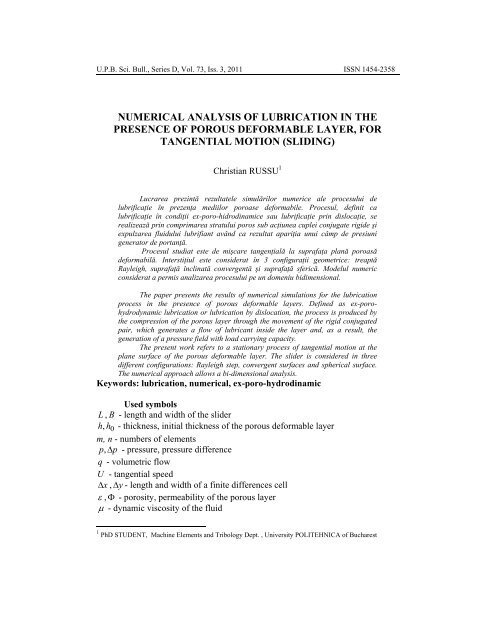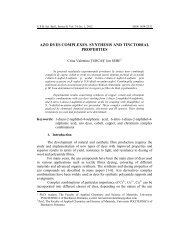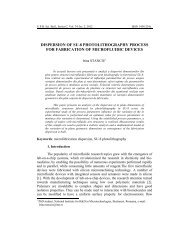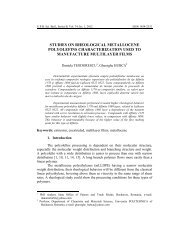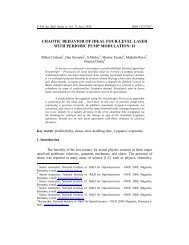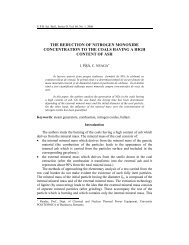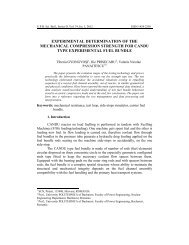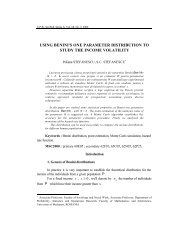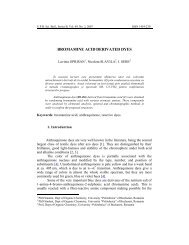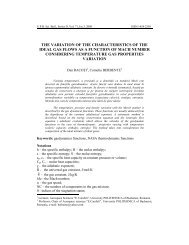U - Scientific Bulletin
U - Scientific Bulletin
U - Scientific Bulletin
You also want an ePaper? Increase the reach of your titles
YUMPU automatically turns print PDFs into web optimized ePapers that Google loves.
U.P.B. Sci. Bull., Series D, Vol. 73, Iss. 3, 2011 ISSN 1454-2358<br />
NUMERICAL ANALYSIS OF LUBRICATION IN THE<br />
PRESENCE OF POROUS DEFORMABLE LAYER, FOR<br />
TANGENTIAL MOTION (SLIDING)<br />
Christian RUSSU 1<br />
Lucrarea prezintă rezultatele simulărilor numerice ale procesului de<br />
lubrificaţie în prezenţa mediilor poroase deformabile. Procesul, definit ca<br />
lubrificaţie în condiţii ex-poro-hidrodinamice sau lubrificaţie prin dislocaţie, se<br />
realizează prin comprimarea stratului poros sub acţiunea cuplei conjugate rigide şi<br />
expulzarea fluidului lubrifiant având ca rezultat apariţia unui câmp de presiuni<br />
generator de portanţă.<br />
Procesul studiat este de mişcare tangenţială la suprafaţa plană poroasă<br />
deformabilă. Interstiţiul este considerat în 3 configuraţii geometrice: treaptă<br />
Rayleigh, suprafaţă înclinată convergentă şi suprafaţă sferică. Modelul numeric<br />
considerat a permis analizarea procesului pe un domeniu bidimensional.<br />
The paper presents the results of numerical simulations for the lubrication<br />
process in the presence of porous deformable layers. Defined as ex-porohydrodynamic<br />
lubrication or lubrication by dislocation, the process is produced by<br />
the compression of the porous layer through the movement of the rigid conjugated<br />
pair, which generates a flow of lubricant inside the layer and, as a result, the<br />
generation of a pressure field with load carrying capacity.<br />
The present work refers to a stationary process of tangential motion at the<br />
plane surface of the porous deformable layer. The slider is considered in three<br />
different configurations: Rayleigh step, convergent surfaces and spherical surface.<br />
The numerical approach allows a bi-dimensional analysis.<br />
Keywords: lubrication, numerical, ex-poro-hydrodinamic<br />
Used symbols<br />
L , B - length and width of the slider<br />
h , h 0 - thickness, initial thickness of the porous deformable layer<br />
m, n - numbers of elements<br />
p, Δp - pressure, pressure difference<br />
q - volumetric flow<br />
U - tangential speed<br />
Δ x , Δy<br />
- length and width of a finite differences cell<br />
ε , Φ - porosity, permeability of the porous layer<br />
μ - dynamic viscosity of the fluid<br />
1 PhD STUDENT, Machine Elements and Tribology Dept. , University POLITEHNICA of Bucharest
146 Christian Russu<br />
1. Introduction<br />
Starting with the last decade of the second millennium a new lubrication<br />
mechanism was developed, based on highly compressible porous layers imbibed<br />
with fluids (HCPL). Studies on this type of mechanism were developed<br />
independently at University POLITEHNICA of Bucharest [1, 2, 3, 4, 5] and at<br />
City University of New York [6, 7].<br />
Named ex-poro-hydrodynamic (XPHD) lubrication [1], this type of<br />
lubrication is strongly dependent on porosity and permeability variation and<br />
considers the forces generated by elastic compression of the solid phase of the<br />
porous layer as negligible.<br />
Known models of XPHD sliders treat cases of lubrication through<br />
dislocation process in one-dimensional manner, thus neglecting the flow in<br />
direction normal to the motion (side flow). The present work intends to analyze a<br />
more realistic model accounting for side flow effects. Comparisons between<br />
numerical results and those predicted by previously published analytical, onedimensional<br />
models, are presented.<br />
2. The model and the numerical approach<br />
The general model considered in the paper can be represented by a slider<br />
moving on a plane surface consisting of a rigid substrate covered by a porous<br />
deformable layer (fig. 1). The slider “dives” into the porous layer and, by its<br />
movement, dislocates the lubricant found inside porous material. Three different<br />
shapes of sliders are considered: stepped, sloped (generating a convergent gap),<br />
and spherical.<br />
W<br />
W<br />
W<br />
L<br />
L<br />
L<br />
a) U<br />
a) U<br />
a) U<br />
b)<br />
h min<br />
h 0<br />
h 0<br />
b)<br />
h min<br />
b)<br />
h min<br />
h 0<br />
c)<br />
Stepped<br />
slider<br />
c)<br />
Sloped<br />
slider<br />
c)<br />
Spherical<br />
slider<br />
Fig. 1. Physical model.<br />
a) slider<br />
b) porous deformable layer<br />
c) rigid substrate
Numerical analysis of lubrication […] porous deformable layer, for tangential motion (sliding) 147<br />
The finite differences method based on "control volume" formulation (that<br />
allows for flow conservation on the cell) has been employed for numerical<br />
simulation. A n×m uniform grid is defined on the rectangular domain. For each<br />
grid point, a control volume is defined with midway points between the<br />
neighboring points. The general structure of a meshed domain is presented in fig.<br />
2. It is to be mentioned that nodes corresponding to line k are, for the Rayleigh<br />
step case, the nodes along the step line.<br />
q j+<br />
q i- q i+<br />
q in<br />
q j-<br />
x<br />
Δx<br />
B<br />
i=1 i=m<br />
j=n<br />
j=k<br />
L<br />
z<br />
Δz<br />
j=1<br />
Fig. 2. Grid layout and control volume (cell) flow balance<br />
For any element inside the domain (represented in the upper left corner of<br />
fig. 2) the flow balance can be written as:<br />
q<br />
j+ + q<br />
j−<br />
+ qi+<br />
+ qi−<br />
= qin<br />
(1)<br />
The left side member represents the flow toward the neighboring elements<br />
(outward flow). For porous permeable media this flow is governed by the Darcy<br />
Law:<br />
A⋅Φ ⋅Δp<br />
q =<br />
(2)<br />
μ ⋅ L<br />
in which the permeability Φ is defined using a form of Kozeny Carman equation<br />
[4] :<br />
3 2<br />
ε ⋅ d<br />
Φ =<br />
180( 1−<br />
ε ) 2<br />
(3)<br />
Applied to the given geometry of a finite differences cell, this becomes:
148 Christian Russu<br />
Φi,<br />
j ⋅ hi,<br />
j ⋅ Δx<br />
p j + − p j Φi,<br />
j ⋅ hi,<br />
j ⋅ Δx<br />
p j − − p j<br />
q j + =<br />
⋅<br />
q j − =<br />
⋅<br />
η Δz<br />
η Δz<br />
(4)<br />
Φi,<br />
j ⋅ hi,<br />
j ⋅ Δz<br />
pi+<br />
− p<br />
Φ h z<br />
i<br />
i,<br />
j ⋅ i,<br />
j ⋅ Δ pi−<br />
− pi<br />
qi+<br />
=<br />
⋅<br />
qi−<br />
=<br />
⋅<br />
η Δx<br />
η Δx<br />
The right side member of eq. 1 defines the source term for the element.<br />
Generally speaking, this is the quantity of the fluid that enters or exits the cell<br />
through other ways than the neighboring elements – in our case as result of<br />
dislocation effect. The definition of this flow depends on the shape of the slider.<br />
For Rayleigh step, the value is 0, except for the nodes found on the line<br />
overlapped with the step (corresponding to the j=k line). For these nodes, we<br />
have:<br />
q in = Δx<br />
⋅ε 0 ⋅ ( h0<br />
− hmin<br />
) ⋅U<br />
(5)<br />
For convergent surfaces model, we have the same value for each cell,<br />
resulting from the constant slope of the slider:<br />
h h<br />
q x U 0 − min<br />
in = Δ ⋅<br />
(6)<br />
n<br />
For the spherical slider case, the value of the inside flow depends on the<br />
position of the element:<br />
Δx<br />
⋅ Δy<br />
⋅U<br />
⋅ ( h h )<br />
q<br />
in<br />
=<br />
i− 1,<br />
j<br />
−<br />
i,<br />
j<br />
(7)<br />
where local thickness of the porous layer is calculated using the first 2 terms of<br />
the Taylor series and thus approximating sphere with a paraboloid.<br />
2<br />
2<br />
2<br />
r<br />
( )<br />
( x − B / 2) + ( y − L / 2)<br />
h x,<br />
y = h(<br />
r)<br />
= ha<br />
+ = ha<br />
+<br />
(8)<br />
d<br />
d<br />
Boundary conditions are imposed by attributing zero values for pressures<br />
in the nodes located at the edge of the geometrical contact surface. Additionally,<br />
for the spherical slider for the nodes situated in the divergent zone of the contact,<br />
if the calculated pressure is negative, the 0 value is attributed automatically during<br />
each iterative cycle.<br />
The problem was solved using the Gauss-Seidel iterative method with the<br />
control on average pressure between two successive cycles. The end iteration<br />
condition was that relative difference between two iterations is smaller than 10 -6 .<br />
The program was written in Pascal and run on a Pentium 4 class processor. The<br />
total solving time for one case varied between 30 and 170 seconds.<br />
3. Results<br />
For a qualitative assessment of the influence of the width/length ratio of<br />
the slider, pressure distributions are presented for Rayleigh step and convergent<br />
surfaces cases.
Numerical analysis of lubrication […] porous deformable layer, for tangential motion (sliding) 149<br />
It can be observed that the maximum pressure is achieved for Rayleigh<br />
step, as expected, on the step line (fig. 3). But with the decrease of the mentioned<br />
ratio, the side flow becomes more and more important. Hence, from the tip effect<br />
found for B/L=2 ratio, we find a transition toward a side flow effect covering the<br />
entire surface of the contact in the case of B/L=0.5.<br />
L 2<br />
L<br />
L 1<br />
U<br />
B/L=0.5 B/L=1 B/L=2<br />
Fig. 3. Qualitative comparison of the influence of B/L ratio on normalized pressure field.<br />
Rayleigh step model.<br />
h min<br />
L<br />
h 0<br />
U<br />
B/L=0.5 B/L=1 B/L=2<br />
Fig. 4. Qualitative comparison of the influence of B/L ratio on normalized pressure field.<br />
Convergent surfaces.<br />
For convergent surfaces (fig. 4) we notice that the decrease of the width<br />
also has an influence on the position of the maximum pressure. As the B/L ratio<br />
becomes smaller, the place of this maximum moves backward, to the trailing edge<br />
of the contact.<br />
It is to be mentioned that these values do not represent absolute pressures<br />
but normalized ones, obtained by division to the maximum value. For the analysis<br />
of the absolute values, a different kind of representation was chosen. The pressure
150 Christian Russu<br />
distributions found on the symmetry plane are represented against values<br />
calculated via analytical, one-dimensional model (figs. 5 & 6). It can be observed<br />
that the maximum values decrease as B/L ratio becomes smaller, going down to<br />
50% from the value calculated analytically, as the point where this value is<br />
achieved moves toward the trailing edge.<br />
Normalized pressure distribution<br />
Normalized pressure distribution<br />
1.2<br />
1<br />
0.8<br />
0.6<br />
0.4<br />
0.2<br />
0<br />
1.2<br />
1<br />
0.8<br />
0.6<br />
0.4<br />
0.2<br />
0<br />
Analytical<br />
onedimensional<br />
B/L=1<br />
B/L=0.5<br />
B/L=2<br />
0 0.2 0.4 0.6 0.8 1<br />
Dimensionless coordinates x/L<br />
Fig. 5. Pressure distribution in median section.<br />
Rayleigh step model. Analytical vs. numerical.<br />
Analytical<br />
onedimensional<br />
B/L=2<br />
B/L=1<br />
B/L=0.5<br />
0 0.2 0.4 0.6 0.8 1<br />
Dimensionless coordinates x/L<br />
Fig. 6. Pressure distribution in median section.<br />
Convergent gap model. Analytical vs. numerical.<br />
For the spherical model, we have a convergent zone of the contact<br />
followed by a divergent one. This limits the real active area as shown in fig. 7. It
Numerical analysis of lubrication […] porous deformable layer, for tangential motion (sliding) 151<br />
can be noticed that, as the spherical slider sinks deeper into the porous layer (as a<br />
result of higher load or lower tangential speed), the active area gets a butterfly<br />
aspect, with its end retracting toward the geometrical center of the contact.<br />
Shallow dive and deep dive are related to the relative degree of compression of<br />
porous layer: ε min / ε0<br />
= 0. 9 for shallow dive and ε min / ε0<br />
= 0. 1 for deep dive.<br />
U<br />
Shallow dive Medium dive Deep dive<br />
Fig. 7. Qualitative comparison of the influence of dive depth of the slider.<br />
Spherical model.<br />
4. Conclusions<br />
Numerical results were validated through comparison to analytical,<br />
one-dimensional model, proving that finite differences algorithm was<br />
implemented correctly.<br />
Normalized pressure distribution<br />
1.2<br />
1<br />
0.8<br />
0.6<br />
0.4<br />
0.2<br />
0<br />
Rayleigh<br />
step<br />
Spheric<br />
Convergent<br />
surfaces<br />
0 0.2 0.4 0.6 0.8 1<br />
Dimensionless coordinates x/L<br />
Fig. 8. Pressure distribution in median section, for the three considered models.<br />
A comparison between the three models considered for the same dive into<br />
the porous layer and speed (fig. 8) shows that, for step and convergent surfaces
152 Christian Russu<br />
models, both maximum values and the area of the pressure fields are similar, yet<br />
there is a small advantage for the Rayleigh step model.<br />
As for the spherical slider, this suffers mainly because of the divergent<br />
zone, an important part of the active area of the contact being lost. For Rayleigh<br />
step and convergent surfaces, the considered sliders are of square shape (B/L=1)<br />
with the side of the square equal to the diameter of the spherical slider.<br />
B I B L I O G R A P H Y<br />
[1] M.D Pascovici, “Procedure and Device for Pumping by Fluid Dislocation”, Romanian Patent,<br />
109469 (in Romanian), 1994<br />
[2] M.D.Pascovici, “Lubrication by Dislocation: A New Mechanism for Load Carrying Capacity”.<br />
In: Proceedings of 2nd World Tribology Congress, Vienna, p.41 (Paper on CD), 2001<br />
[3] M.D.Pascovici, T.Cicone, V.Marian, “Squeeze Process under Impact, in Highly Compressible<br />
Porous Layers, Imbibed with Liquids.”. In: 13th Nordic Symposium on Tribology,<br />
Tampere, Finland, 2008, published in Tribology International, Vol. 42, Issue 10, pp.1433-<br />
1438, 2009<br />
[4] M.D. Pascovici, C.S.Popescu, V. Marian, “Impact of a Rigid Sphere on a Highly Compressible<br />
Porous Layer Imbibed with a Newtonian Liquid.”. In: J. Engineering Tribology Proc.<br />
IMechE Vol. 224, Part J, pp. 789-795, 2010<br />
[5] C. S. Popescu, “Numerical Study of Dynamic Loading in Ex-Porohydrodynamic Lubrication.<br />
3D Case Study: Human Footprint Impact Over a Highly Compressible Porous Layer<br />
Saturated with Water”. In: U.P.B. Sciientific <strong>Bulletin</strong>, Series D, Vol. 73, pp. 279-290, Iss.<br />
2, 2011<br />
[6] J Feng and S.Weinbaum, “Lubrication Theory in Highly Compressible Porous Media: The<br />
Mechanics of Skiing, from Red Cells to Humans”, J. Fluid Mechanics 422, 281-317, 2000<br />
[7] Wu, Q., Andreapoulos, Y. and Weinbaum, S., “From Red Cells to Snowboarding: A New<br />
Concept for a Train Track”, Phys. Review Letters, 93, 19, 194501-1, 194501-4, 2004.<br />
[8] S.V. Patankar, Numerical Heat Transfer and Fluid Flow, McGraw-HillBook House 1980.


